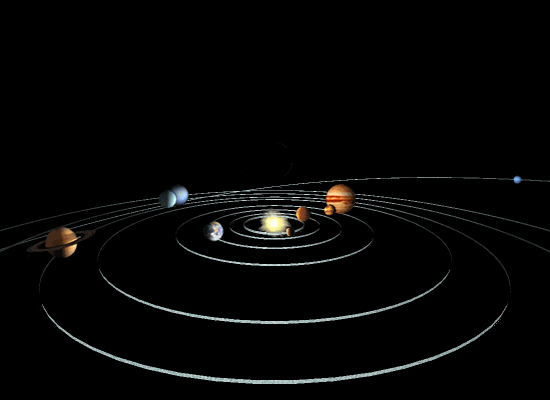
| The Origin of The Solar System |

| My
Very Educated Mother Just Served Us Nine Pickles (Mercury, Venus, Earth, Mars, Jupiter, Saturn, Uranus, Neptune, Pluto) |
The
Universe created - 15 billion years ago.
Our Sun, and the solar system - 4.6 billion years ago.

The Sun - our lone star - just as any other star, was formed when gravity pulled together a cloud of interstellar gas.

The rotating ball collapsed into a thin disk about 4.6 billion and years ago, with the Protosun (cloud of gas that will develop into the Sun) located at the center. In the disk, solid material accumulates into larger and larger particles, forming planetesimals, protoplanets, and planets.and allowed it to differentiate, namely, to separate materials according to their density. Heavy metals, such as iron and nickel, settled in the core, while the lightest silicates "floated" to the surface.
An important
clue to the origin and formation of the solar system is the
clear division of the planets
into two categories: Terrestrial,
such as the Earth, and Jovian, such as Jupiter. The
terrestrial planets are: Mercury,
Venus, Earth, and
Mars. They lie in the inner solar system and
are small, dense, rocky worlds
with less atmospheres than the Jovian
planets: Jupiter, Saturn,
Uranus, and Neptune.
The Jovian planets lie in the outer solar system - beyond
the asteroid belt - are large,
gaseous, low-density worlds. Poor Pluto does
not fit either category very well: it is small, like the
terrestrial planets, but lies far away from the Sun and has a
low density just like the Jovian planets. It is now not even
considered to be a planet.
|
|
|
|
|
|
|
|
|
|
|
|
|
|
|
|
|
|
|
|
|
|
|
|
|
|
|
|
|
|
|
|
|
|
|
|
|
|
|
|
|
|
|
|
|
|
|
|
|
|
|
|
|
|
|
|
|
|
|
|
|
|
|
|
|
|
|
|
|
In what is the outer solar system, four very large masses formed and became the four Jovian planets. All of these planets grew to have masses of at least 15 times the mass of the Earth. Once a planet has grown to such a large mass, it has a strong enough gravitational pull to begin capturing gas directly from the solar nebula, the material from which the Sun was formed: 74% Hydrogen, 24% Helium, and 2% of the heavier elements. Thus, the Jovian worlds are low-density worlds rich in hydrogen and helium.
In the inner part of the solar system there were simply too many collisions for large planets to form; from the four terrestrial planets Earth is the most massive one - with only 1/320 times the mass of Jupiter - Venus (with 82% percent of the Earth's mass) is the next, and then Mars (10% of the Earth's mass) and Mercury (5% of the Earth's mass) are the lightest. The terrestrial planets are dense worlds - with low hydrogen and helium content - because they are composed mostly from the 2% of the heavier elements contained in the solar nebula.
The solar
system is filled with smaller bodies, such as satellites
(moons), asteroids, and comets. Our own moon was probably created
in a catastrophic collision between the Earth and a Mars-size
planet. Some of these smaller bodies, however, have
settled in the asteroid belt between Mars and Jupiter, while a
few were captured as the moons
of planets..
Rings around the giant planets, such as the ones in Saturn:

are probably the result of stray
planetesimalshen they ventured too close to the planet.